EQization: Resolving Frequency Conflicts
Let's begin with
Often, beginners are faced with the problem of the incoherence of their musical composition: all the instruments individually sound good, as it should, and in the mix we get a slurred “mess”. And the reason for this “misunderstanding” is especially the structure of our auditory apparatus, in the so-called auditory disguise.
A few words about auditory disguise
If the instruments have similar (or overlapping) frequency spectra, then a quieter timbre will be heard worse or the listener's brain will not be able to emit this signal at all. Imagine how you are standing on the platform in the subway and talking nicely, while a train rushes past with such a squeal that you cease to understand each other. The fact is that the frequency spectrum of our voice intersects with the frequency range of the hum of a passing electric train - this is the masking effect.
There is a problem? Find a solution!
Fortunately, a solution has long been found without us, so we can only reap the rewards and rejoice. The solution is equalization.
Equalizer (EQ)
Equalizer is a tool for adjusting the amplitude-frequency characteristic (AFC) of an audio signal, that is, it is a device that allows you to "retouch" the original timbre by changing the amplitude of its frequency component.
It’s probably worth starting with the fact that the main types of equalizer 2: graphic and parametric. There is also paragraphic (a hybrid of the first and second types) and offshore, which is used mainly in the final processing of the phonogram, that is, at the mastering stage. Within the framework of this article, the last 2 equalizers will not be considered, because they are not the jungle.
Graphic equalizer

“Iron” graphic equalizer
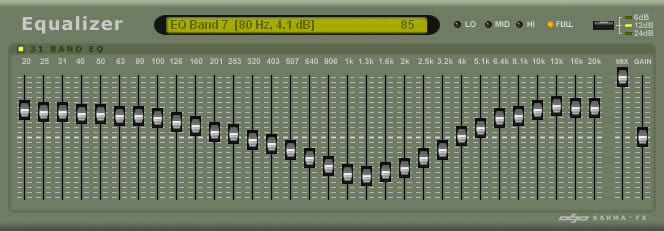
Software graphic equalizer The graphic equalizer
looks like this in hardware and software. The essence of such an equalizer is quite simple: the extreme bands are usually shelf filters.
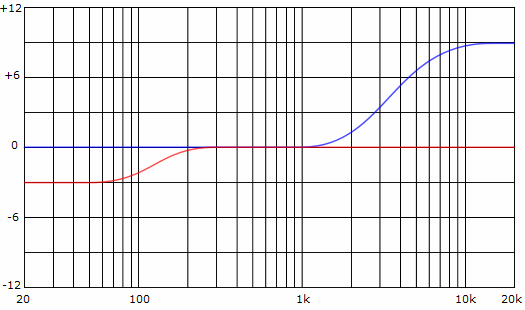
Low Shelf filter (red line, the leftmost fader of the graphic equalizer is lowered down by -3 dB) and High Shelf (blue line, in this position the rightmost fader is raised up by +6 dB)
and all the others have a “bell-shaped” characteristic:
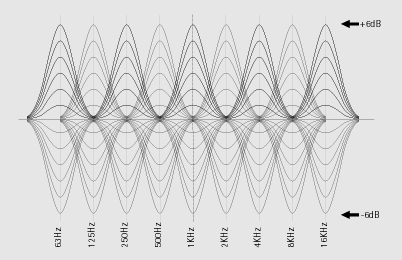
The width and frequency of each band is programmed in such an equalizer, so this type is not very flexible and interferes with the original audio signal quite roughly. Therefore, let’s leave this miracle of technology quietly sitting on the sidelines and move on to the next, more important for us, type of equalizer - parametric.
Parametric Equalizer

This type of equalizer has much more flexible settings for each band in comparison with its “brother”:
- Frequency (Freq) - band frequency
- Parameter Q - bandwidth or "quality factor"
- Gain - level of gain (attenuation) of the selected band in decibels (dB)
A parametric equalizer is a godsend for solving such problems as the elimination of frequency conflicts, since the ability to select a frequency for correction is simply necessary. So, first things first.
Overview of 3 Parametric EQs
Have you ever had an equalizer? Just for this case I will present you good (in my opinion) software EQ.
Note: the equalizers presented below are VST / RTAS / DX or AU plug-ins (Mac) requiring a host (software sequencer): Cubase / Nuendo, Sonar, Ableton, Logic Pro, Pro Tools, FL Studio, etc.
Sonnox Oxford EQ

This is the "classic of the genre" in the world of software parametric equalizers. Sonnox Oxford has 5 tuning sections for the corresponding 5 bands, 2 of which are High Pass (high-pass filter) and Low Pass (low-pass filter).
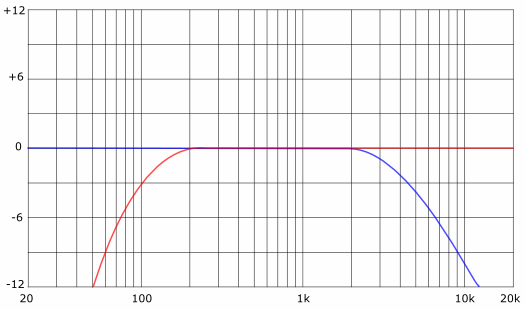
Low Pass (red) and High Pass (blue)
having a very good steepness of 36 dB per octave (this is quite enough in most cases). There are 2 settings blocks and buttons “A” and “B” in the center for quick switching between the options of these settings.
From the “-” I would note the following:
- Lack of spectrum analyzer (but this is not critical for EQ)
- Both filters have cutoff frequency restrictions, low-pass filter 0-400 Hz,
high-pass filter 1000-20 000 Hz, which is not always convenient.
EQality from DMG Audio

A pretty good equalizer with three phase modes (you can get acquainted with the phase-frequency characteristic of the equalizers if you wish ), a good high-resolution span analyzer with six bands and 2 filters with a stunning 48 dB per octave cutoff. It is possible to roll back changes (Undo, Redo), save and load presets, as well as flexible interface settings. The CPU loads weakly, so you can safely hook it on at least every bus in the mixer.
Of the minuses, I would note that with a mixdown (rendering) in the audio file, the processing and automation of the parameters of this equalizer disappears somewhere. Perhaps the problem is only with me, but I would strongly recommend checking this equalizer before use for a similar defect.
FabFilter Pro – Q

I personally use it, very satisfied. You can create up to 24 bands (including LP and HP filters), equalize the left and right channels separately, has 2 tuners (like Sonnox) and an excellent spectrum analyzer working in two modes: Pre-EQ (before processing with an equalizer) and Post-EQ (after processing, respectively). Sorry, I did not reveal any flaws. No, I’m lying, an honest person will have to pay 150 euros for this miracle (if this, of course, can be called a drawback).
Unfortunately, all these 3 EQs are paid, but as a free trial you can try ReaEQ, which is part of Cockos's ReaPlugs VST FX Suite (creator of the REAPER workstation), now you have plenty
to choose from, so let's get started!
Resolving Frequency Conflicts
Bass and barrel
The most common case is the conflict between the bass and the barrel, in this example we will analyze the “what's what.” Such a conflict cannot even be partially resolved by panning (removing two tools from each other in space, i.e., along the left and right channels), since both of these tools should be centered. And there are 2 solutions: SideChain compression (there are a lot of cognitive materials on this topic on the Internet ) that allows you to muffle the bass at the time of the barrel attack, and equalization when such a “quality” (as with SideChain) is simply not needed.
You can, of course, initially pick up such bass and barrel that will not conflict with each other. But here's another thing when you like this particular bass and this particular barrel, here the equalization is a breath of clean air.
To start the equalization of the bass and kicks into the Insert gap, you need to “hang up” the equalizer (which, I hope, will not cause difficulties) and turn on the spectrum analyzer (in the circuit after EQ), or your ears if you trust your perfect hearing, but better both. If your equalizer does not have a built-in spectrum analyzer, I would recommend using Voxengo's SPAN - a good (and most importantly free) analyzer, which you can read about here .

This image shows the analyzer operation process in parallel operation. In this mode, SPAN is able to analyze two audio signals in one window, which is undoubtedly convenient. You can repeat similar things at home, it is completely safe, and even useful! It says how to do it.
So, we have 2 spectra (the bass spectrum on the left and the barrels on the right):
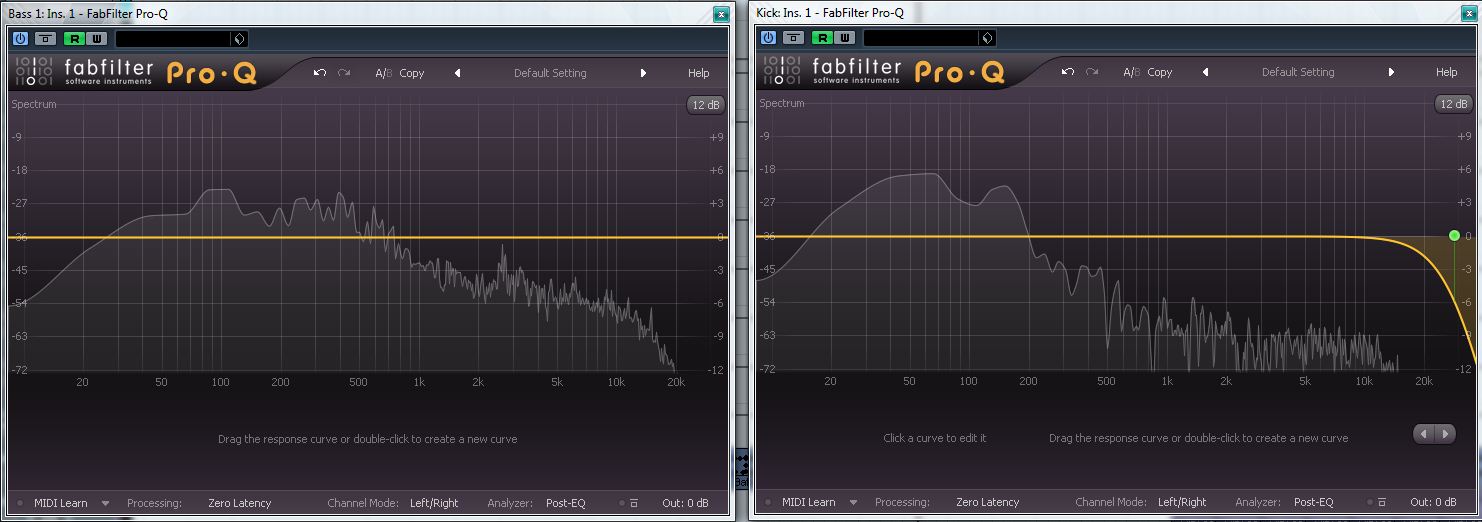
Since a barrel with a pronounced low-frequency component (an extreme large hump), having extinguished which we lose all its dynamics, the task becomes more difficult. If you pick up the hump around 150 Hz (the second small hump), you can lose the characteristic kick of the barrel and get a bubbling blank.
Based on the fact that the project has a sub-bass that occupies a band of up to 90 Hz, we will select everything below 90 Hz from the bass and use a narrow band (always cut with a narrow band!) And cut 150-160 Hz from the bass (Just to the right of the hump). It will look something like this:
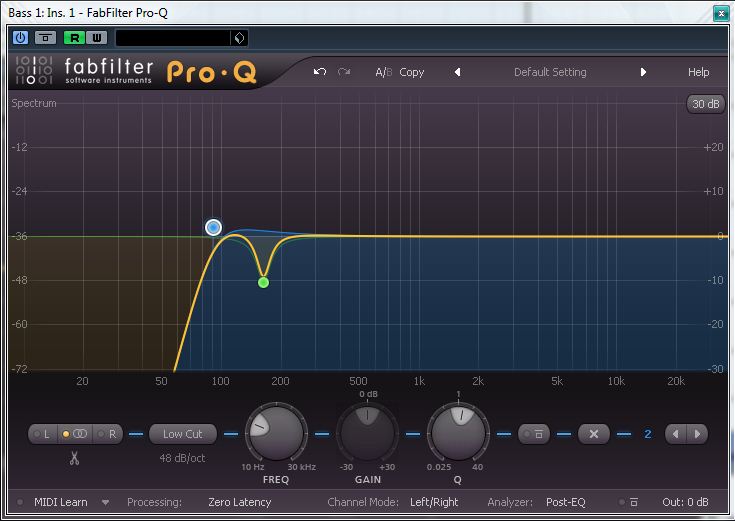
Note: the conflict between the sub-bass and the kick in this case was resolved using SideChain compression.
A barrel can be distinguished by a distinctive click for better readability in the mix. To understand where this click is located, you need to create a narrow band in the region of 1000 Hz, raise it by 6-9 dB and walk this band to 2000-3000 Hz (rarely a little higher), you should hear it. Having determined the very place where the click of the barrel was “hidden”, lower the band to 2-4 dB (the main thing is not to overdo it) and make it a little wider: You

need to remember 2 very important rules:
- It is necessary to cut a narrow strip, add a wide one, and the higher the frequency, the wider the strip (the lower the Q parameter);
- When performing equalization of instruments while mixing material, first try to cut (filter), and only then raise the frequencies.
Eliminating the conflict between bass and kick by the equalization method is not always easy, often requiring a creative approach. If the “humps” of these instruments strongly overlap each other, perhaps you should think about changing the barrel, equalization in this case can ruin the whole mix.
Conflict between bass and mid-range instruments
Almost all instruments are in the mid-frequency range and many of them have a low-frequency component (hum and noise), which can conflict with the bass. Therefore, many can cut the bottoms without compromising the sound of the party in the mix.
We create a Low Pass filter on the selected instrument, press “Play” and begin to pick up the bottoms until you feel the changes.
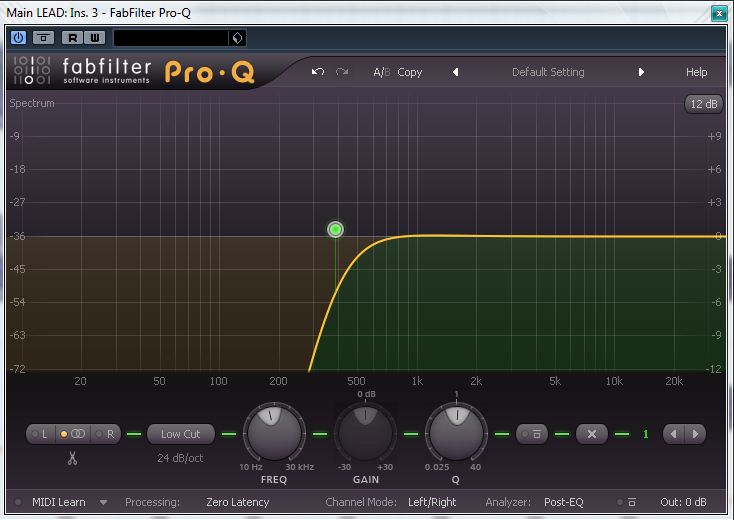
Note: in this case, do not use too large a slope (36 or 48 dB) to leave something like a “crossfade” of the spectra.
The main thing is that the part should sound “as it should” in the mix, and not separately, which is why we cut the bottoms during playback. As soon as you feel that the timbre begins to lose density, stop and make a small rollback. Thus, you can work with many tools and eliminate most of the conflicts in the lower middle.
Frequency Tool Conflicts
With all other instruments, the situation is much simpler than with the bass and barrel, if only because you can pan these instruments into different channels, using one very important rule: the higher the frequency range occupied by the instrument, the farther you can pan from the center . After that, they can be equalized, based on their position in space.
A few words about the "niche" for vocals
If there is vocals in your composition, then you need to free up space for it, otherwise a conflict with mid-range instruments is simply inevitable. Fortunately, you already know what spectrum analysis is and how to apply it when equalizing. Why just make room, and not clean up the vocals in some places? The fact is that the vocals are equalized minimally and very carefully, the bottoms are cut most often in the vocals (up to 150-200 Hz) and a small area in the region of 1000 Hz to eliminate the unpleasant "nose" sound.
To summarize
- Before equalizing the instruments, pan using one very important rule: the higher the frequency range occupied by the instrument, the farther you can pan from the center. It’s important to know: you can pan everything except the bass, barrel and main vocals.
- Start eliminating frequency conflicts with the bass and the kick, gradually moving to higher instruments.
- When analyzing a spectrum, highlight its strong parts. Visually, they appear in the form of "humps."
- If the "humps" of the bass and the barrels overlap greatly, it might be worth considering changing the barrel, the equalization in this case can ruin the entire mix, deprive it of assertiveness.
- Cut the frequency should be a narrow strip, and add a wide one.
- By filtering the bottoms of mid-range instruments, you can eliminate most of the conflicts in the lower middle.
- When working with vocals, it is important to free up space for it in the mix, and in no case not vice versa.
- Equalization - interference in the frequency response of the instrument / timbre, be careful - know the measure.
- Do not perform all the equalization “from and to” in one session, let your ears rest, they quickly get used to the sound (including the “wrong” one).
- If you have to apply a lot of equalization to any instrument, think about it, maybe this instrument has no place in the mix.
Important: at some points in this article, the subjective point of my view is reflected; everything described here is not an axiom and has a cognitive character.
Friends, colleagues, success in all your creative endeavors!
